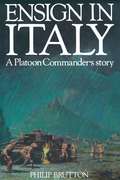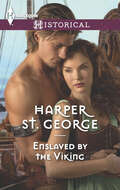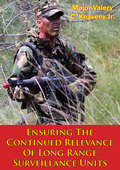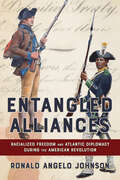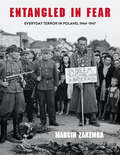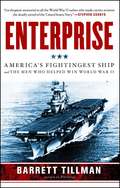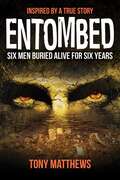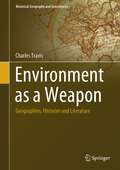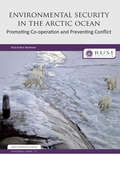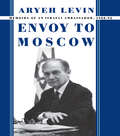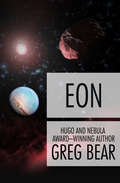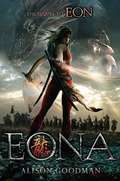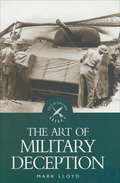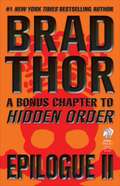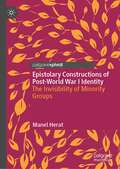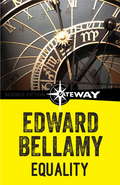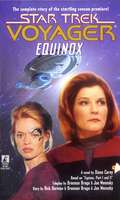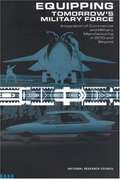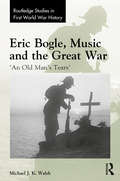- Table View
- List View
Ensign in Italy: A Platoon Commander's Story
by Philip BurtonIn 1943, aged 18, Philip Brutton relinquished his place at Cambridge to volunteer for the Welsh Guards. He was commissioned the same year and was Ensign of the Guard as St James's Palace when a near miss by the Luftwaffe hit and badly damaged the surrounding area. At 19, in early 1944, he was sent to Italy where he joined his Regiment and was soon on patrol in the dead-man's-land of the Cassino ruins, threading his way nightly through the minefields, under constant threat of enemy attack, shelling and mortaring. He survived to fight with the 3rd Battalion Welsh Guards as a young battle-hardened platoon commander throughout the major encounters of the Italian campaign involving 1st Guards' Brigade. In Austria, under orders, he handed over the Croatian Government and then 2000 men plus their families to their communist executioners: the Great Betrayal. A regular officer, he was stationed in Palestine before the end of the British Mandate, and after a period with The Prince of Wales's Company, 1st Battalion Welsh Guards, he became a Staff Captain at Headquarters 1st Guards' Brigade, aged 21.
Enslaved by the Viking: An Intense Story of Forbidden Passion (Viking Warriors #1)
by Harper St. George"From this day forward, you are mine." The moment Merewyn sets eyes on the warrior standing atop a Viking raiding ship, something inside her stirs. By all rights, she should fear him, should run from him, yet she cannot help but be drawn to him. Eirik has never before taken a woman captive, yet Merewyn inspires a longing that calls to the darkness within him. He takes her back to his homeland as his slave, where they finally succumb to passion. And as the lines between captor and captive blur, Eirik realizes they have crossed into dangerous territory...
Ensuring The Continued Relevance Of Long Range Surveillance Units
by Major Valery C. Keaveny Jr.Long Range Surveillance Units (LRSUs) provide a unique and necessary capability to today's commanders and to commanders who will fight in the future. In looking to the future operational environment, LRSUs must ensure their ability to operate across the full spectrum of operations at a rapid tempo and in a short-notice, force projection Army. Current LRSU doctrine is primarily built around the AirLand Battle doctrine of the Cold War, a conventional threat, linear battlefield, and employment at great distances behind enemy lines. As a result, LRSU doctrine and Tactics, Techniques, and Procedures (TTPs) require update or change. These changes will ensure continued LRSU relevance and their maximum effectiveness.This study identifies an increased and unaddressed emphasis on target acquisition, Stability and Support Operations, and operations in urban environments. These operations lend themselves to non-traditional and creative tasking of LRSUs and will necessitate increased requirements for friendly unit coordination, vehicular insertion, and potential task organization of reconnaissance elements.This study recommends changes to doctrine, tactics, techniques, procedures, and training based on lessons learned by LRSUs on recent operational missions and the lessons of similar units. These changes require proponent leadership, LRS community teamwork, and warrant additional Army oversight and assistance.
Entangled Alliances: Racialized Freedom and Atlantic Diplomacy During the American Revolution (The United States in the World)
by Ronald Angelo JohnsonEntangled Alliances is a reinterpretation of the American Revolution through analysis of diplomacy in the emerging United States during decades of hemispheric transformation. Ronald Angelo Johnson brings to light the fascinating story of American patriots and rebels from Saint-Domingue (later Haiti) allying against European tyranny.The American Revolution occurred between two of the greatest achievements in diplomacy of the eighteenth century: the peace treaties at Paris in 1763 and 1783. In Entangled Alliances, Johnson draws on original multilingual sources to offer readers fresh, lively stories in a timely study. While modern understandings of freedom are often linked to the US Declaration of Independence, Johnson argues that the desire of Black Atlantic inhabitants for liberty and their will to resist slavery predated the fateful standoff between minutemen and redcoats at Lexington and Concord.Entangled Alliances is a US history of the American Revolution, fusing the search for freedom by Black and white founders in the United States and Saint-Domingue into a coherent story of collective resistance during the most explosive twenty-year period of the eighteenth century.
Entangled in Fear: Everyday Terror in Poland, 1944–1947
by Marcin Zaremba"Fear is always experienced individually, and few experiences are as personal. There can be no collective fear without individual fear preceding it. A society's fear is born out of the convergence of individual experiences, when dozens, hundreds, thousands, and millions of people are afraid of the same thing at the same time." This is a story about postwar Polish society and its emotions. This is a story of heroes: soldiers, deserters, orphans, and beggars. Now available in English for the first time, Entangled in Fear reveals the broken society where bandits, hunger, bombs, Russia, and countless other threats had an immense influence on Poles as they struggled through the wreckage caused by World War II. Journalist and historian Marcin Zaremba uses sociology, psychology, and history to explore collective fear in official documents and the personal papers of those who were left to survive in postwar Poland. In doing so, he reveals how fear of famine and epidemics, sexual violence and looting, joblessness and invasion led directly to collective action on the part of Poles. A groundbreaking work, Entangled in Fear challenges the reader to consider how emotions have shaped human history and how a more serious engagement with emotions is key to a fuller understanding of the past.
Enterprise: America's Fightingest Ship and the Men Who Helped Win World War II
by Barrett TillmanThis is the epic and heroic story of the aircraft carrier USS Enterprise and of the courageous men who fought and died on her from Pearl Harbor to the end of the conflict. Acclaimed military historian Barrett Tillman recounts the World War II exploits of America’s most decorated warship and its colorful crews— tales of unmatched daring and heroism.
Entombed: Six Men Buried Alive for Over Six Years
by Tony MatthewsWhat would it be like to be trapped deep underground for six long years with no hope of rescue or escape? This is a profound question explored deeply in Entombed. And the key point here is that Entombed is inspired by an astonishing true story and real events. Six German soldiers led by Captain Hans von Roth are accidentally buried alive in a vast subterranean stores bunker at the port of Gdynia, Poland, in 1945. At first they believe they will soon be rescued, but as the weeks drag into years it becomes appallingly clear that the men will almost certainly face a terrifying death in the grim darkness that surrounds them. Meanwhile, in Berlin, Hans von Roth&’s wife, Erika, is desperately attempting to survive the fall of the city and the Russian hordes destined shortly to occupy it. Facing starvation, massive aerial bombing, Soviet shelling and a host of other dangers, she is also attempting to discover what has become of her lost husband. In Entombed, the author has woven a tale of great love and a desperate struggle for survival like no other. The story literally pushes all the frontiers of human frailty and courage to their very edges.
Environment as a Weapon: Geographies, Histories and Literature (Historical Geography and Geosciences)
by Charles TravisEnvironment as a Weapon considers how the confluence of war and nature from the time of the Agricultural Revolution (10,000 BCE) to our present day has been represented in works of history, geography, and literature. In the Epic of Gilgamesh, the Torah and Greco-Roman myths, warfare is a trope commensurate with environmental disasters, extreme climate, and plague. In the medieval age myths the Táin, and Beowulf environments become allies and enemies. The equestrian steppeland as foundation of Genghis Khan’s and his heirs Pax Mongolica is chronicled in The Secret History of the Mongols and The Travels of Marco Polo. The West African Griot legend of Sundiata and the Little Ice Age wreck of the Spanish Armada in 1588 speak to oceanic and atmospheric dimensions of warfare. American Revolution political pamphlets, poetry, diaries and weather logs, reflect the severe weather and terrain deployed by George Washington’s early campaigns in the war of independence. Napoleon’s midwifing of Total War is captured in Mary Shelley’s Frankenstein, Leo Tolstoy’s War and Peace, and Charles Minard’s Carte figurative carto-graph of the disastrous 1812 French invasion of Russia. The U.S. Civil War and the organic-industrial assembles of its battles, arguably the first Anthropocene War, is parsed by the clarifying poetry of Emily Dickinson. Geopolitik and geo-hazards of flood and fire feature in the Global War works of Samuel Beckett, Kurt Vonnegut and James Dickey. The literature of Vietnamese and American war combat veterans reveals how North Vietnam’s Environmental Military Complex stalled the American Military Industrial Complex in the jungles, and R&R districts of southwestern Asia. Finally, he sci-fi of H.G. Wells’ World Set Free and David Mitchell’s Cloud-Atlas frame Oppenheimer’s sub-atomic deployments at Hiroshima and Nagasaki, James Lovelock’s ‘Gaia’ and U.S. military discourses situating global warming as a national security threat to America. Indeed, Environment and War ironically resonates with U.N. Secretary General António Guterres proclamation that “seventy-five years ago, the world emerged from a series of cataclysmic events: two successive world wars, genocide, a devastating influenza pandemic . . . Our founders gathered in San Francisco promising to save succeeding generations from the scourge of war.” Thus, a holistic approach to studying and mitigating the human and environmental impacts of warfare, must integrate methods from the arts, humanities and sciences. This involves understanding how the historical geographies of the Earth’s planetary systems have been perceived, deployed and emerged as agents of warfare, with the lithosphere, hydrosphere, cryosphere, biosphere and atmosphere transformed as arsenals against anthropogenic global warming. This book will be of interest to geographers, historians, and scholars in environmental studies, climate change, literature and military studies, as well as the broader environmental humanities.
Environmental Cleanup at Navy Facilities: Risk-Based Methods
by National Research CouncilThe fiscal and technological limitations associated with cleaning up hazardous waste sites to background conditions have prompted responsible parties to turn to risk-based methods for environmental rememdiation.Environmental Cleanup at Navy Facilities reviews and critiques risk-based methods, including those developed by the U.S. Environmental Protection Agency and the American Society of Testing and Materials. These critiques lead to the identification of eleven criteria that must be part of any risk-based methodology adopted by the Navy, a responsible party with a large number of complex and heavily contaminated waste sites. January
Environmental Information for Naval Warfare
by Committee on Environmental Information for Naval UseAccurate and timely environmental information can provide a tactical advantage to U. S. naval forces during warfare. This report analyzes the current environmental information system used by the U. S. Navy and Marine Corps and recommends ways to address uncertainty and leverage network-centric operating principles to enhance the value of environmental information.
Environmental Security in Latin America
by Gavin O'TooleThis book examines security in Latin America through an environmental lens, at a time when this region faces a broad and growing spectrum of threats. The book considers the backdrop against which security debates about Latin America have been conducted; the extent to which scholarship has been dominated by traditional US strategic concerns; and how, in the changing context at the end of the Cold War, some policymakers within Latin America itself at both national and regional levels began to reposition security. It argues that traditional security scholarship focusing on military defence and strategic affairs in this region is hard to explain and out of date, and offers reasons why a new focus on environmental threats within a broader human security perspective has much to offer this field. Such a focus is justified by the scale of the challenges that environmental degradation is posing in Latin America, and the very real impact of climate change there. The book considers how the various theoretical possibilities of the term ‘environmental security’ all have some potential application to this region, where the natural environment is rapidly being securitized by military forces on behalf of their states. Finally, it proposes that a fruitful approach to Latin America might be one where human and environmental security have parity. This book will be of interest to students of environmental security, Latin American security, human geography and IR in general.
Environmental Security in the Anthropocene: Assessing Theory and Practice (Critical Security Series)
by Judith Nora HardtThis book provides a critical assessment of the theories and practice of environmental security in the context of the Anthropocene. The work analyses the intellectual foundations, the evolution and different interpretations, strengths and potential of the link between environment and security, but also its weaknesses, incoherencies and distortions. To do so, it employs a critical environmental security studies analytical framework and uniquely places this analysis within the context of the Anthropocene. Furthermore, the book examines the practice–theory divide, and the political implementation of the environmental security concept in response to global environmental change and in relation to different actors. It pays significant attention to the Environment and Security Initiative (ENVSEC), which is led by different programs of the United Nations, the OSCE and until recently by the North Atlantic Treaty Organization (NATO), among others, and has largely been overlooked in the academic literature to date. The goal is to study how environmental security practice could inform and shape the environmental security theory, and also to explore how, conversely, new theoretical insights could contribute to the enhancement of environmental security activities. This book will be of great interest to students and academic scholars of Environmental Security, Critical Security Studies, Green Political Theory, Global Governance and International Relations in general.
Environmental Security in the Arctic Ocean: Promoting Co-operation and Preventing Conflict (Whitehall Papers)
by Paul Arthur BerkmanThe North Pole is being transformed from a sea-ice cap to a seasonally ice-free sea within the next few decades. This fundamental shift in the boundary conditions of the Arctic Ocean will create a new natural system with different dynamics than anything previously experienced by humans in the region. With the diminishing ice cover, interests are awakening globally to take advantage of extensive energy, shipping, fishing and tourism prospects in the Arctic Ocean. A range of states, including the major Arctic powers, are increasingly asserting their sovereignty seawards. National security policies are being declared and nuclear-capable states are adjusting their strategic deployments in the Arctic Ocean. There are forums for international cooperation in the Arctic, most notably the Arctic Council, but peace in the Arctic Ocean has yet to be explicitly established as a common interest because of the long-standing military presence. Risks of political, economic and cultural instabilities are inherent consequences. This volume proposes environmental security as providing a holistic framework to assess these security risks and then identify the appropriate adaptation and mitigation responses. Only after shared risk assessment and understanding of the appropriate responses, will there be sufficient clarity about the governance paths to pursue within the international legal framework of the law of the sea.
Envoy to Moscow: Memories of an Israeli Ambassador, 1988-92 (Cummings Center Series #Vol. 4)
by Aryeh LevinThe personal memoir of Aryeh Levin, Israel's first Ambassador to Russia since the severance of relations between the two countries in 1967. Aryeh Levin's four-year tenure as Ambassador to Moscow coincided with great upheavals in the life and times of both Israel and Russia. He was witness to the momentous events that led to the collapse of the Soviet empire and was instrumental in facilitating the immigration of almost half a million Jews to Israel.
Eon: A Novel (Eon #2)
by Greg BearFrom the New York Times–bestselling author of War Dogs: A novel that &“may be the best constructed hard SF epic yet&” (The Washington Post). In a supernova flash, the asteroid arrived and entered Earth&’s orbit. Three hundred kilometers in length, it is not solid rock but a series of hollowed-out chambers housing ancient, abandoned cities of human origin, a civilization named Thistledown. The people who lived there survived a nuclear holocaust that nearly rendered humanity extinct—more than a thousand years from now. To prevent this future from coming to pass, theoretical mathematician Patricia Vasquez must explore Thistledown and decipher its secret history. But what she discovers is an even greater mystery, a tunnel that exists beyond the physical dimensions of the asteroid. Called the Way, it leads to the home of humanity&’s descendants, and to a conflict greater than the impending war between Earth&’s superpowers over the fate of the asteroid, in &“the grandest work yet&” by Nebula Award–winning author Greg Bear (Locus).
Eon: A Novel (Eon #2)
by Greg BearFrom the New York Times–bestselling author of War Dogs: A novel that &“may be the best constructed hard SF epic yet&” (The Washington Post). In a supernova flash, the asteroid arrived and entered Earth&’s orbit. Three hundred kilometers in length, it is not solid rock but a series of hollowed-out chambers housing ancient, abandoned cities of human origin, a civilization named Thistledown. The people who lived there survived a nuclear holocaust that nearly rendered humanity extinct—more than a thousand years from now. To prevent this future from coming to pass, theoretical mathematician Patricia Vasquez must explore Thistledown and decipher its secret history. But what she discovers is an even greater mystery, a tunnel that exists beyond the physical dimensions of the asteroid. Called the Way, it leads to the home of humanity&’s descendants, and to a conflict greater than the impending war between Earth&’s superpowers over the fate of the asteroid, in &“the grandest work yet&” by Nebula Award–winning author Greg Bear (Locus).
Eona: The Last Dragoneye (Eon #2)
by Alison GoodmanEon has been revealed as Eona, the first female Dragoneye in hundreds of years. Along with fellow rebels Ryko and Lady Dela, she is on the run from High Lord Sethon's army.
Epehy: Hindenburg Line (Battleground Ser.)
by Bill MitchinsonThe village of Epehy gave its name to one of the most important battles of 1918.Evacuated by the Germans during their retreat to the Hindenburg Line, the ruins were occupied by British Forces until the German offensive. They were recaptured in some of the bloodiest engagements of September 1918.
Epilogue II: A Bonus Chapter to Hidden Order (The Scot Harvath Series)
by Brad ThorIf you read and loved the #1 New York Times bestseller Hidden Order, enjoy this free bonus chapter.Experience the suspense and thrills only Brad Thor can write in Epilogue II, a shocking alternate ending to Hidden Order.
Epistolary Constructions of Post-World War I Identity: The Invisibility of Minority Groups
by Manel HeratThis book analyses the letters of marginalised groups of World War I soldiers - including Black, Indian and disabled ex-servicemen - from a linguistic perspective, looking at issues such as descriptions of disability, identity and migration, dealing with minority groups who have long been rendered invisible, and exploring how these writers position themselves in relation to the 'other'. The author makes use of a corpus-assisted approach to examine identity construction and performance, shedding light on a previously under-explored demographic. This book will be of interest to students and scholars of World War I history, language and identity, psychological and physical disability, as well as readers seeking a fresh angle on a key period of 20th century history.
Equality
by Edward BellamyThe sequel to Bellamy's Looking Backward where a young man falls asleep in 1887 and wakes in a utopian year 2000, where all social ills are solved. This novel continues the thread of his utopian vision.Equality begins when Julian West returns to the year 2000 to continue his education. The book describes an ideal society in that year.
Equinox (Star Trek: Voyager)
by Diane CareyCaptain Janeway believed she commanded the only Starfleet vessel in the Delta Quadrant -- until the U.S.S. Voyager came to the rescue of the U.S.S. Equinox, a battered starship besieged by a ravening horde of extradimensional predators. Helmed by Captain Rudolph Ransom, the Equinox has been trapped in the Delta Quadrant even longer than the Voyager and the ship and its crew show the scars of a constant struggle to survive. But Ransom and his people are hiding something as well: a shocking secret that will ultimately pit captain against captain, starship against starship, in an explosive conflict that may cost Voyager the life of her captain! A powerful novel based on the thrilling two-part television adventure!
Equipping Tomorrow's Military Force: Integration of Commercial and Military Manufacturing in 2010 and Beyond
by National Research CouncilInformation on the Integration of Commercial and Military Manufacturing in 2010 and Beyond
Equity of Evolving Transportation Finance Mechanisms
by The National Academy of SciencesTRB Special Report 303: Equity of Evolving Transportation Finance Mechanisms addresses the equity of alternatives to current transportation finance mechanisms, notably mechanisms based on tolling and road use metering (i.e., road pricing). The committee that developed the report concluded that broad generalizations about the fairness of high-occupancy toll lanes, cordon tolls, and other evolving mechanisms oversimplify the reality and are misleading. The fairness of a given type of finance mechanism depends on how it is structured, what transportation alternatives are offered to users, and which aspects of equity are deemed most important.
Eric Bogle, Music and the Great War: 'An Old Man's Tears' (Routledge Studies in First World War History)
by Michael J. WalshEric Bogle has written many iconic songs that deal with the futility and waste of war. Two of these in particular, ‘And the Band Played Waltzing Matilda’ and ‘No Man’s Land (a.k.a. The Green Fields of France)’, have been recorded numerous times in a dozen or more languages indicating the universality and power of their simple message. Bogle’s other compositions about the First World War give a voice to the voiceless, prominence to the forgotten and personality to the anonymous as they interrogate the human experience, celebrate its spirit and empathise with its suffering. This book examines Eric Bogle’s songs about the Great War within the geographies and socio-cultural contexts in which they were written and consumed. From Anzac Day in Australia and Turkey to the ‘The Troubles’ in Northern Ireland and from small Aboriginal communities in the Coorong to the influence of prime ministers and rock stars on a world stage, we are urged to contemplate the nature and importance of popular culture in shaping contemporary notions of history and national identity. It is entirely appropriate that we do so through the words of an artist who Melody Maker described as ‘the most important songwriter of our time’.
